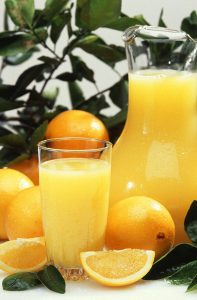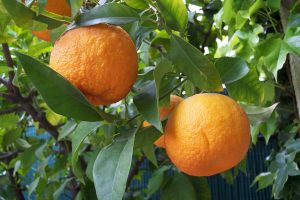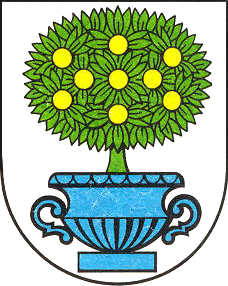By Visiting Professors Dr. Charlie Rohwer and Ulrike Carlson
 I’ve had this dream of doing a full academic etymological study of oranges, with the help of a second-cousin-by-marriage linguist and her historian husband. Being honest with myself, I know that’ll never happen. And also, honestly, they’d have to do all the work anyway.
I’ve had this dream of doing a full academic etymological study of oranges, with the help of a second-cousin-by-marriage linguist and her historian husband. Being honest with myself, I know that’ll never happen. And also, honestly, they’d have to do all the work anyway.
But, the Garden Professor’s Facebook post about the citrus family tree revived my interest. Not for a full-blown academic analysis of the word ‘orange,’ but for a blog-friendly, factual, interesting post. So I got my linguist cousin Ulrike Carlson to edit for accuracy too.
The name given to the orange by Linnaeus was Citrus aurantium, and the only other citrus species he noted in his first volume of Species Plantarum was Citrus medica. The current taxonomy of citron is Citrus medica L., and bitter orange (or Seville orange, used for marmalade and Belgian beer) is Citrus aurantium L. According to Linnaeus, sweet orange and pomelo were separate varieties of C. aurantium (var. sinensis and var. grandis, respectively). For a pretty image of the family tree, see the National Geographic article here. Basically, it is now known that all common citrus fruits are hybrids derived from citron, mandarin, pomelo, and papeda.
The current taxonomy for sweet orange, Citrus sinensis (L.) Osbeck, clearly defines the fruit’s Eastern origin (sinensis comes from Latin for ‘Chinese’) and altered nomenclature (Osbeck refined Linnaeus’ original taxonomy). But the name given to bitter orange, C. aurantium, points to its South Asian origin, and here’s why. The Tamil (south India) word for orange transliterates to ārañcu; Sanskrit words look similar; the Persian nārang is derived from there. As the bitter and sweet orange hybrids were likely made somewhere between Northern India and Southern China, it would be expected that the European names for these fruits come from these or nearby areas too. The origin of Linnaeus’ aurantium are obvious. Aurantium is Latin for the orange tree, and aurancia is the fruit. If you say these words aloud, they all sound similar to each other, to nārang, and to the English orange.
But here’s where it gets more interesting, with a preface: the word apple has historically been used to describe any fruit that’s not a small berry. Also, bitter oranges were common in Europe before sweet oranges. In fact, when sweet oranges came on the scene in the 17th century, wealthy people built greenhouses or gardens (“orangeries”) specifically for the new, more delicious versions of the fruit.
 Orangery at the Château_de_Versailles
Orangery at the Château_de_Versailles
By Djampa – Own work
My first time in the Netherlands, I noticed orange juice is called sinaasapelsap. I don’t know Dutch really, but…doesn’t that mean ‘Chinese apple juice?’ Sinaas: Chinese (sinensis); apel: apple; sap: …sap (juice)? I knew in French that it’s jus d’orange (juice of the orange), and I knew ‘orange’ in Spanish is naranja (looks & sounds a lot like orange and narang). Why would the Dutch call it Chinese apple juice? Fast forward a couple years, I’m in Denmark, and what do I see? Appelsinsaft. CHINESE APPLE JUICE…English, Dutch, Danish, they’re all Germanic languages. Shouldn’t the Germanic languages call it orange juice, like I do? Then it hits me. English is the odd duck here. The Germanic languages call orange juice ‘Chinese apple juice’. This reflects the name Linnaeus gave the sweet orange (var. sinensis, or ‘Chinese’). Best I can tell, among Germanic languages, only English, Afrikaans, and Scots gets their word for the sweet orange from the older word for the bitter orange, nārang.

By A. Barra – Own work
That’s not the last word on the subject though. You can go to Italy for sweet oranges and get arance, the Czech Republic and get pomeranče (apple-orange), Ireland and get oráistí, Bulgaria and get oranzhev, or Portugal and get laranjas (aka, oranges). All words that come from nārang or aurancia. You can go to Estonia, Finland, Sweden, Norway, and Germany and get some kind of Chinese apples (aka, oranges). But even as most Italians eat arance, you’d instead ask for a partuallu in Sicily. Or you’d eat a portokáli in Greece, portokall in Albania, etc. The Portuguese, with their awesome shipping routes, imported sweet oranges from China, then grew and distributed them through Europe in the 17th century. They were a big improvement over the bitter orange (which would you rather have, marmalade from a bitter orange, or a juicy sweet orange?). So some countries called the sweet orange by the name of the proximal country they were shipped from, Portugal. Bitter oranges (AKA Seville oranges, named from where they were grown) are called pomerans (from apple-orange) in Swedish, Pomeranzen or Bitterorangen in German, pomeransen in Dutch…so it seems that when sweet oranges came to Germanic-speaking countries, the languages kept the word they’d been using for the bitter orange (calling it an orange-apple or bitter orange), and added a different word for the sweet orange, calling it a Chinese apple. This is all complicated because political boundaries have changed a lot in Europe, and languages borrow from each other. So northern Germans might still eat Chinese apples, but southern Germans might eat oranges.
Also, if you’re interested and you’ve made it this far, the color orange is so named because that’s the color of the fruit. It’s not the other way around. It’s a pretty recent color descriptor. That’s why robins, with their orange breasts, are called robin red-breast. There was no word for the color orange when the robin was first described.
Also of great interest is the House of Orange. If you’ve seen a Dutch soccer game, or been to the Netherlands, you’ll know they like the color orange. William I of Orange, basically the founder of the Netherlands, came from a principality called ‘Orange’, now in France, and the Dutch celebrate their royal family with the color of its namesake. BUT, Orange, France was named, a couple thousand years ago (before the fruit came to Europe), after a Celtic water god, Arausio. At the time, this had nothing to do with the fruit or the color. HOWEVER, since the middle ages, the crest of the French city shows orange fruit on a branch, and the crest for the German city of Oranienbaum (orange tree) has, you guessed it, an orange tree. According to Wikipedia, Oranienbaum was named after the Dutch House of Orange.

For more about how these languages are related, here’s a ‘simple’ chart.
Very enlightening, thank you for this post!
BTW, the only thing missing is an explanation why in English you compare “apples and oranges” (while in many other languages it is “apples and pears”) 🙂
I say potato, you say kartoffel!
I say tomato, you say tomate!
I say auto liability insurance, you say…Kaftfahrzeug-Haftpflichtversicherung.
Well, another month has gone by without a post from the professors . . . withering on the vine, it seems. I’m sure many besides me are very disappointed.
You’re right – it’s entirely too long between posts. Right now we have very few Garden Professors with the time to contribute to the blog. I’m hoping that will change in the future. You’ll be pleased to see that we have a new one up today.
Hope to read many more posts. FYI Where I grew up pomegranates were called “indian Apples”.
Russian and German are the only languages on which I could be considered an academic expert, but I’ll chime in with what little I know.
I am fairly certain that the term at hand is not German in origin, but one may encounter at times in products marketed in Germanic languages, as well as some very different languages that alongside some Germanic languages.
In all modern dialects of both high and low German of which I am aware, the primary word for “orange” is “Orange,” and the word for “orange juice” is “Orangensaft.” I don’t recall any exceptions to this, but if there are any, I would expect it to be low-country German (near Belgium, Netherlands, etc.) and/or Swiss German.
Anyway, “orange” is “apelsin” in Dutch and “pomme de Sine” in French (although I believe I recall coming across “orange” in French, pronounced oh – ROHNJ). Both Dutch and French have roots in the archaic Frankish language, which may explain how they came to refer to this fruit by phrases that, in their respective languages, literally translate as “apple of China.” “Apelsin” and its approximates are used in a number of other languages, including Estonian, Swedish, and Russian (апельсин).
I was very interested to read what your relative said about Proto-Indo-European concept, as the Indo-European family is the taxonomic “least common factor” under which one would find Germanic, Indic, and Balto-Slavic languages. In a sense, it appears both the naranj and apelsin camps diverged early in Indo-European divergence, and more recently reconverged in a number of language sub-families in Europe.
As anyone studying linguistics would expect, the wildcards here are Finnish and Estonian. These are two of the three most prevalent languages that most scholars categorize in the Finno-Ugric (or Uralic; either is correct) language family. The third is Hungarian, which uses “narancs”–clearly borrowed from the Indic branch of languages. It appears that the word may have arrived in Sweden through Danish and Dutch languages, and of course Swedes made their way into Finland and established a large ethnic enclave in Estonia, which we cleverly call “Estonian Swedes.”
Please note: anything I have couched in less-than-certain language is a hypothesis; anything in certain terms is my humble recollection of what I learned while studying, working, and instructing in grownup linguistics and languages fields, of which I should emphasize I am no longer an active professional member.
Cheers!
Just to add a bit – I’m an American born second gen Lithuanian (and yes, orange is apelcinas). Interesting personally since both of my parents were certain that there was no Lithuanian translation for both the color or the fruit. They always believed that Apelcinas was incorrect. Now, it makes sense. Also – any thoughts on orange carrots, and their connection to the Netherlands historically? Wondering how that fits into the narrative?
Carrot domestication happened in central Asia, and that may have included orange carrots too. Carrots from Asia weren’t called ‘orange’ because there was no word for ‘orange’, but art clearly shows orange carrots from much earlier than the Dutch ‘developed’ them. Today’s archetypical orange carrots come more recently from Dutch stock. There’s a well-sourced history at the carrot museum: http://www.carrotmuseum.co.uk/history5.html#orange.
You can tell today’s carrots come from a Dutch past because of their names and pedigree. We grow ‘types’ of carrots with shape and size categories like Imperator, Chantenay, Nantes, Danvers, Berlicum (look in any seed catalog!). These are all names of old varieties that are traceable to the variety ‘Horn’, named after the Dutch town Hoorn. (cool!) http://www.carrotmuseum.co.uk/history.html.
But I don’t know how much the enthusiasm for the color orange influenced the popularity of orange carrots in 16th century-Netherlands (and since) …